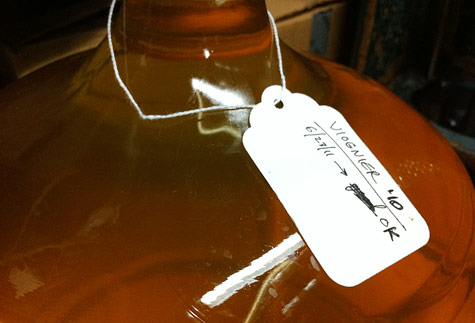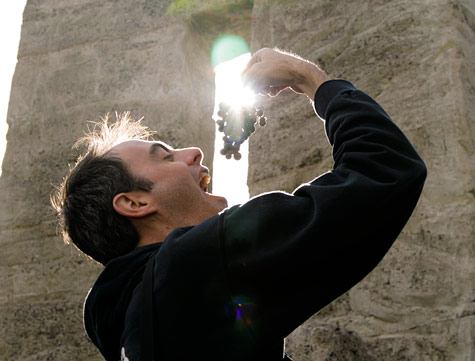Archive for the 'Les Garagistes' Category
Update 2010: The Troubled Ones
 … and at last we come to the wines that haven’t exactly breezed through our underground lair. Not to say they might not be lovely some day, but for now: curse you, Bacchus!
… and at last we come to the wines that haven’t exactly breezed through our underground lair. Not to say they might not be lovely some day, but for now: curse you, Bacchus!
Today, our Viognier; next, the Rosé. Hmmm: they’re both white (or white-ish) wines. Just a coincidence, you say? Ah, gentle reader, that’s why we love you…
Viognier
This is our first year with this varietal, and we unwittingly made a huge tactical error right out of the gate: we didn’t have a herky enough press to really extract everything from this notoriously thick-skinned grape. That meant a much smaller yield than was our due, but it’s probably also why our wine is so acidic — just a hair over 3.0 pH: we’re working with just juice, not the (I’m guessing) riper compounds in the grape skins that resisted our press’ embrace.
So it’s a bit on the… refreshing side. “Crisp,” one might say. A “food wine,” as the wine industry spins its more bracing effluent. Maybe even: that “mom’s secret to whiter teeth” you’ve seen manically waving its hand in the back row of every web site, urging you to call on it.
Okay, enough ganging up on our gaunt Viognier. In its defense, it does still smell utterly lovely (peaches, pears, spice) — and the acidity is likely to preserve that nicely until its infrastructure begins to soften. So with luck, it’ll simply be a wine we’ll want to lay down for a year or so before enjoying.
And we haven’t just let it sit there, shivering in its acidity. To balance the low pH with more flavor and dimension, we’ve kept it on its lees, which we’ve been stirring once a week or so. That was an invaluable tip we got from Riesling specialist and all-around brilliant winemaker Matt Berson, of Love and Squalor Wines, and it really seems to have helped.
And not content to leave barely-well-enough alone, I also thought I’d try one last gambit to offset this wine’s high pitch: I added a touch of oak. Not much, and not for long, but yeah, maybe I do have some kind of death wish where whites are concerned. The idea was to add just enough to add some depth, but not enough to oak it into chardonnay — a fate worse than… brrrr, let’s change the subject!
But after just two weeks, I pulled a sample and — Yellow my Tail! — oak vanillin already seemed to have plowed over the fragrance! I immediately yanked it off the oak and the lees, and I’ve let it sit quietly to calm itself after its brief stroll walking the streets.
Then, this morning, I thiefed a sample: time to face the music. How badly had I F’d it up? But hmmm, you know what? The oak does seem to have descended into the wine, leaving the lovely Viognier fragrance intact but adding a bit of flesh to the wine — despite its still-bracing acidity. I’d been thinking we should fine this before bottling, but maybe we ought to let whatever particulate is still there continue its broadening effect and then just decant if there’s significant settling in the bottle.
Dare I say it? The yay may well be back in our Viognier! Time will tell…
No commentsUpdate 2010: The good
 Part Two of your 2010 update…
Part Two of your 2010 update…
Cabernet Sauvignon
The Cab in particular betrayed a self-destructive love of the EA (ethyl acetate) this year, so we’ve had to carpet bomb it with sulfite to jerk it back onto the straight and narrow. The good news is that it now appears to be EA-free, and as it emerges from beneath its heavy blanket of sulfite, it seems pretty nice, though still hard to get a clear sense of.
The EA problem also had at least one downstream consequence: some of the Cab is pretty dang oaky. That’s because the EA was particularly bad in our half barrel, so we (I think wisely) quarantined it until it was cured. But as a result, because that half barrel was new, the Cab therefore soaked up more new oak than we’d normally have liked.
I don’t think it’s a disaster by any means, but as a general rule, our philosophy is that oak should be like salt in food — if you notice it, you’ve put in too much. This year, whether we like it or not, we’ll see what happens when we’re forced to ignore that rule. The downside is oaky, woody vanillin potentially dominating; the upside, though, is more tannic backbone than we’re used to, so it’ll be very instructive to see how that unfolds over time. (How’s that for “[wine] glass half-full” take on things!?)
Merlot
I know: to sum up this wine’s life story as “it is what it is”, as I did earlier, is unfair and probably a little lazy, too — fashion has made looking down on Merlot way too easy. Nevertheless, this year’s Merlot is exactly that — Merlot — an amiable, good-natured wine that offers great companionship with little complication. We’ve lowered our harvest of this grape over the years, mostly because its part in the Peugeot blend has dropped over time, but I for one still enjoy it. There’s something comforting about a wine waiting for you when you get home on a weekday, wagging its tail with unconditional love. Who else is so glad to see you every time? Not that Cabernet, anyway — at least for now…
Next, the problem children…
No comments2010 Update: the pretty damn good
As promised in a few days ago, here’s the next installment of how our 2010 wines are faring. We begin with dessert: the wines that really seem like they’ll be excellent — assuming we let them make it to bottle and don’t gleefully guzzle them right now.
Cabernet Franc
We like to rack the Franc only two or three times over the year, supposing that minimal handling will help preserve its bewitching aroma. One of those rackings was a few weeks ago, and like a saucy mermaid, it beckoned us with a irresistible floral nose, and then lured us ever-further into the depths with succulent, floral fruit. Wow. Once again, this will be both hard to blend away and deservedly form the backbone of the Peugeot.
Syrah
I’ve opened two 2009 Syrahs in the last couple of weeks, and holy crap, this is the most adult wine I think we’ve ever made: deep and powerful but unmistakably syrah (vs. liquid oak with varietal flavoring, as many are). The 2010 looks to be a good follow-up, but with better acidity and rich, crisply-articulated fruit resonating through great depth. Awesome.
Grenache
This is the first year we’ve tried Grenache, and typical of our sober, judicious approach to winemaking, we blindly hurled ourselves over the edge, investing heavily. Luckily, it paid off: when we racked it about a month ago, its aroma was as bewitching as the Franc’s, but more luscious and Provençal-herby. Thankfully, we’ll have enough to bottle separately and cast in our first Côtes-du-Rhône blend this year. It’ll be one stunning leading lady in that road show.
Mourvedre
We pressed this varietal into service for the first time this year as the third leg of a Côtes-du-Rhône stool, but to our suprise, it stands on its own just fine, thank you. Inky dark, and redolent of pepper and roses. Holy moley.
Pinot Noir
After three vintages working with fruit from a highly reputed Dundee Hills vineyard, our Pinot this year is finally beautiful — if willowy. Since this varietal totally ate our lunch in the 90s, we’ve been pretty gun-shy about it: as with white wines, its essential delicacy means there are fewer places to hide crappy fruit or bad winemaking, both of which we had in ample supply back in the day. As a result, for the last few years we’ve only produced small batches as “side-bets” for the braver Garagistes.
This year, I’m proud to report, it looks like that bet will pay off, in part because we’re better winemakers, but more importantly, because we’re working with better fruit. Of course, 2010 was a lighter vintage in Oregon — no Parker wines this year without heavy manipulation — and our Pinot is no anomaly. But it’s not watery or bland. It’s just… elegant, with beautiful, focused fruit. We put a little oak on it a month ago (just a little), so by the time we bottle it in September, it ought to be really lovely.
No commentsSummer Garagistes update
 Harvest 2011 is just now visible on the horizon, and the prospect of a fresh river of juice has similarly quickened this blog out of its traditional winter/spring slumber. [yawn] Good morning! What did we miss?
Harvest 2011 is just now visible on the horizon, and the prospect of a fresh river of juice has similarly quickened this blog out of its traditional winter/spring slumber. [yawn] Good morning! What did we miss?
Quite a bit, as it turns out. Despite the radio silence here at Les Blog, we’ve actually been busy little microbes downstairs, racking wines, adjusting this and that, and rigorously sampling our wares to ensure top quality (oh, was that what we were doing?). As a result, I have a few reports to share with you over the next few days on how all the varietals in our stable downstairs are faring:
- Cabernet Sauvignon
- Merlot
- Cabernet Franc
- Syrah
- Mourvedre
- Grenache
- Pinot Noir
- Viognier
- Rosé (of Grenache)
Overall, I think this vintage has produced truly excellent wines, primarily because the late, cool harvest meant higher acidity in just about everything. So the wines have structure and liveliness straight off the vine, and that I think will make this year’s crop arguably one of the best we’ve ever overseen.
But for scientific reasons I only dimly understand, the vintage also presented its share of problems, in particular a low-level epidemic of EA (ethyl acetate – think nail polish remover) through a number of the wines. Thanks to great advice from friends who are real winemakers, and some timely intervention on our part, all of our wines muscled through the EA and are now perfectly sound, but WTF? You’d think those higher acidities would afford some protection, but that EA must have tunneled in through the basement of the flower shop next door or something…
Anyway, based on where things taste now, I can say this: the 2010 Cabernet Franc, Grenache, Mourvedre, and Syrah will be utterly stunning. The Pinot Noir will also be lovely and elegant, though reflective of the lighter vintage. The Cabernet Sauvignon is a bucking, unruly stallion I don’t think we’ve quite tamed yet, but we will. The Merlot is… Merlot. The Viognier will also be lovely, but very… crisp, as the wine industry likes to spin high-acid wines. And the Rosé — man, it may yet excel, but it’s one sullen teenager.
So on the eve of blending trials, our wines fall into three categories: great, good, and problematic. Next up in a day or so, more on the great, followed in due course by reports on the other two.
No commentsStill fermenting!
Incredibly, the rosé still hasn’t finished fermenting — nearly 5 months after it started. The hint of CO2 in the head space does give the game away, but I’d assumed that was simply residual. So I checked the sugar: 1.75%, oceans away from dry. And it tastes it, too. Lovely nose, but too sweet in the mouth, like strawberry jam.
A long, cool fermentation is apparently just the thing for whites (and semi-whites like rosés), so I haven’t been too concerned. And the CO2 tells me the yeasts are still alive in there — it’s just been too cold to do much of anything, something with which I think we can all sympathize. But it’s time for these guys to get off the couch, shed the Snuggies, and finish the job. Unlike last year, I’d like to get this rosé sealed up early enough that it’s over bottle shock by the time the first warm Saturday afternoon rolls around.
So we’ll wrap the carboys in our electric mattress pad and apply just a hint of heat. I’m a little worried that malolactic fermentation will also jump-start (while malo’s just the thing for reds, it can muddy and over-soften whites), but que sera, sera. Malo seems to proceed much more slowly than primary fermentation, so with luck, the yeasts will race far ahead of the malo bugs and we can seal up a lovely rosé before things get too mellow.
No comments
